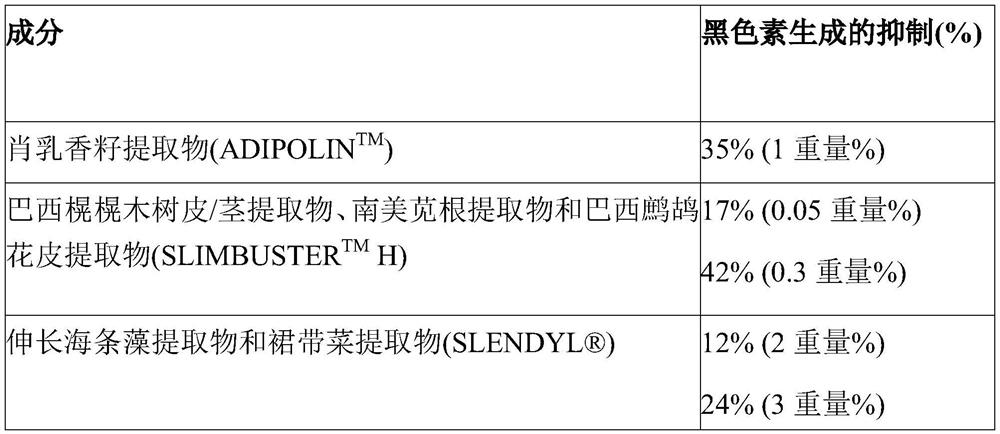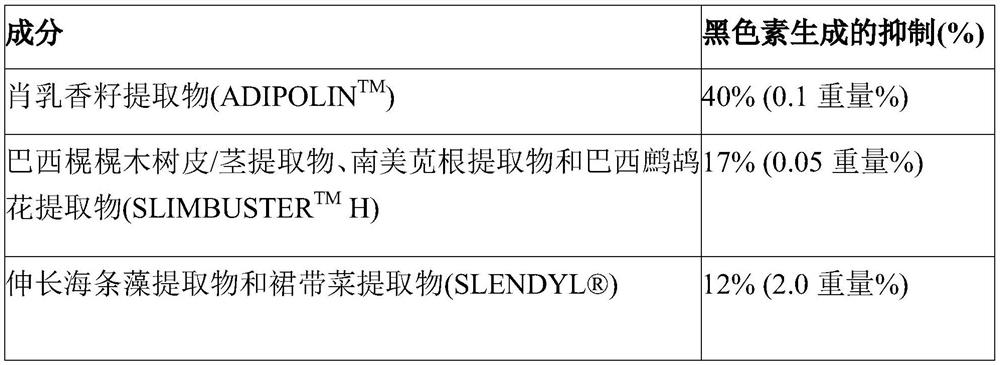Plant extracts to reduce the appearance of hyperpigmented skin or to lighten skin
A pigmentation and extraction technology, applied in at least two, at least four, kinds, at least three fields, can solve the problems of prolonged recovery period, skin irritation, high cost, etc.
- Summary
- Abstract
- Description
- Claims
- Application Information
AI Technical Summary
Problems solved by technology
Method used
Image
Examples
Embodiment 1
[0099] (in vitro activity)
[0100] B16 Melanogenesis Assay: A B16 pigmentation assay was performed on each of the extracts identified in Table 1 below. This assay measures the ability of a given substance (in this case a plant extract) to reduce melanogenic activity in skin cells. In particular, melanogenesis is the process by which melanocytes produce melanin, the naturally occurring pigment that gives skin, hair and eyes their color. Inhibiting melanogenesis is beneficial in preventing skin dullness and lightening dark spots associated with aging. B16 Pigmentation Bioassay B16-F1 melanocytes (ATCC), an immortalized mouse melanoma cell line, were used to analyze the effect of the plant extracts identified in Table 1 on melanin production. The endpoints of this assay are spectrophotometric measurements of melanin production and cell viability. 10% CO at 37°C 2 B16-F1 melanocytes were cultured in standard DMEM growth medium with 10% fetal bovine serum (Mediatech) and then ...
Embodiment 2
[0113] (clinical efficacy study)
[0114] A plant-based material selected from the group consisting of Boswellia sativa seed extract, murella braziliana bark / stem extract, amaranthus root extract, Brazilian partridge flower extract, Laminaria elongata extract and / or wakame extract Combinations can be tested in clinical studies to determine the efficacy of these compositions in clinical tests such as skin lightness and skin redness measured by a colorimeter, macular hyperpigmentation scored by a dermatologist Reduction, increase in skin radiance, skin firmness and elasticity as scored on clinician's assessment, reduction in overall photodamage as scored on clinician's assessment, and increase in evenness of skin tone as scored on clinician's assessment. Additional tests may include levels of erythema, redness, dryness, peeling, flaking, irritation, burning, stinging, itching, or tingling, self-rated by clinical study participants. These results are expected to indicate that th...
Embodiment 3
[0123] (additional analysis)
[0124] It can be determined by methods known to those of ordinary skill in the art that can be used to determine any one of the ingredients disclosed throughout the specification and claims, or any combination of ingredients, or a composition having a combination of said ingredients Analysis of efficacy. The following are non-limiting assays that can be used in the context of the present invention. It should be appreciated that other testing procedures may be used including, for example, objective and subjective procedures.
[0125] Mushroom Tyrosinase Activity Assay: In mammalian cells, tyrosinase catalyzes two steps in the multistep biosynthesis of melanin from tyrosine (and polymerization from dopachrome). Tyrosinase is located in melanocytes and produces melanin (aromatic quinone compound) that gives skin, hair and eyes their color. In the presence or absence of each of the active ingredients disclosed in this specification, any combinatio...
PUM
 Login to View More
Login to View More Abstract
Description
Claims
Application Information
 Login to View More
Login to View More - R&D
- Intellectual Property
- Life Sciences
- Materials
- Tech Scout
- Unparalleled Data Quality
- Higher Quality Content
- 60% Fewer Hallucinations
Browse by: Latest US Patents, China's latest patents, Technical Efficacy Thesaurus, Application Domain, Technology Topic, Popular Technical Reports.
© 2025 PatSnap. All rights reserved.Legal|Privacy policy|Modern Slavery Act Transparency Statement|Sitemap|About US| Contact US: help@patsnap.com



